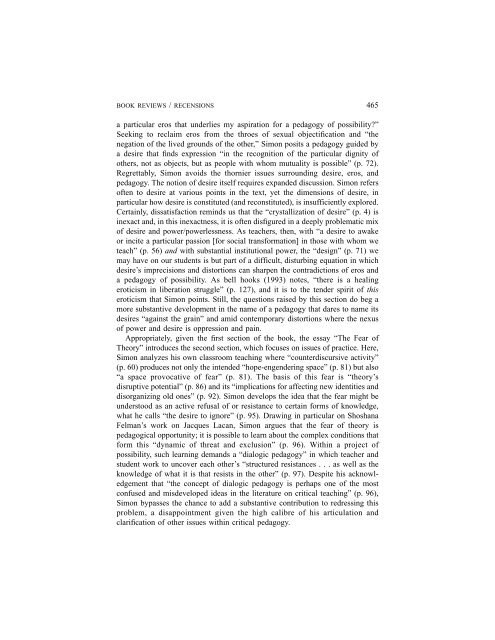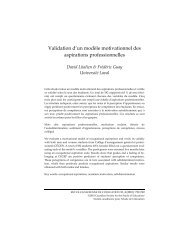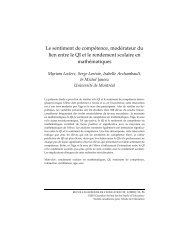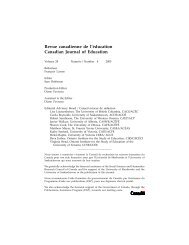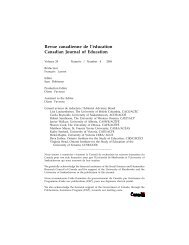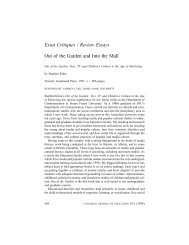Mireille Falardeau et Michel Loranger Le choix de stratégies ... - CSSE
Mireille Falardeau et Michel Loranger Le choix de stratégies ... - CSSE
Mireille Falardeau et Michel Loranger Le choix de stratégies ... - CSSE
You also want an ePaper? Increase the reach of your titles
YUMPU automatically turns print PDFs into web optimized ePapers that Google loves.
BOOK REVIEWS / RECENSIONS 465<br />
a particular eros that un<strong>de</strong>rlies my aspiration for a pedagogy of possibility?”<br />
Seeking to reclaim eros from the throes of sexual objectification and “the<br />
negation of the lived grounds of the other,” Simon posits a pedagogy gui<strong>de</strong>d by<br />
a <strong>de</strong>sire that finds expression “in the recognition of the particular dignity of<br />
others, not as objects, but as people with whom mutuality is possible” (p. 72).<br />
Regr<strong>et</strong>tably, Simon avoids the thornier issues surrounding <strong>de</strong>sire, eros, and<br />
pedagogy. The notion of <strong>de</strong>sire itself requires expan<strong>de</strong>d discussion. Simon refers<br />
often to <strong>de</strong>sire at various points in the text, y<strong>et</strong> the dimensions of <strong>de</strong>sire, in<br />
particular how <strong>de</strong>sire is constituted (and reconstituted), is insufficiently explored.<br />
Certainly, dissatisfaction reminds us that the “crystallization of <strong>de</strong>sire” (p. 4) is<br />
inexact and, in this inexactness, it is often disfigured in a <strong>de</strong>eply problematic mix<br />
of <strong>de</strong>sire and power/powerlessness. As teachers, then, with “a <strong>de</strong>sire to awake<br />
or incite a particular passion [for social transformation] in those with whom we<br />
teach” (p. 56) and with substantial institutional power, the “<strong>de</strong>sign” (p. 71) we<br />
may have on our stu<strong>de</strong>nts is but part of a difficult, disturbing equation in which<br />
<strong>de</strong>sire’s imprecisions and distortions can sharpen the contradictions of eros and<br />
a pedagogy of possibility. As bell hooks (1993) notes, “there is a healing<br />
eroticism in liberation struggle” (p. 127), and it is to the ten<strong>de</strong>r spirit of this<br />
eroticism that Simon points. Still, the questions raised by this section do beg a<br />
more substantive <strong>de</strong>velopment in the name of a pedagogy that dares to name its<br />
<strong>de</strong>sires “against the grain” and amid contemporary distortions where the nexus<br />
of power and <strong>de</strong>sire is oppression and pain.<br />
Appropriately, given the first section of the book, the essay “The Fear of<br />
Theory” introduces the second section, which focuses on issues of practice. Here,<br />
Simon analyzes his own classroom teaching where “counterdiscursive activity”<br />
(p. 60) produces not only the inten<strong>de</strong>d “hope-engen<strong>de</strong>ring space” (p. 81) but also<br />
“a space provocative of fear” (p. 81). The basis of this fear is “theory’s<br />
disruptive potential” (p. 86) and its “implications for affecting new i<strong>de</strong>ntities and<br />
disorganizing old ones” (p. 92). Simon <strong>de</strong>velops the i<strong>de</strong>a that the fear might be<br />
un<strong>de</strong>rstood as an active refusal of or resistance to certain forms of knowledge,<br />
what he calls “the <strong>de</strong>sire to ignore” (p. 95). Drawing in particular on Shoshana<br />
Felman’s work on Jacques Lacan, Simon argues that the fear of theory is<br />
pedagogical opportunity; it is possible to learn about the complex conditions that<br />
form this “dynamic of threat and exclusion” (p. 96). Within a project of<br />
possibility, such learning <strong>de</strong>mands a “dialogic pedagogy” in which teacher and<br />
stu<strong>de</strong>nt work to uncover each other’s “structured resistances ...aswell as the<br />
knowledge of what it is that resists in the other” (p. 97). Despite his acknowledgement<br />
that “the concept of dialogic pedagogy is perhaps one of the most<br />
confused and mis<strong>de</strong>veloped i<strong>de</strong>as in the literature on critical teaching” (p. 96),<br />
Simon bypasses the chance to add a substantive contribution to redressing this<br />
problem, a disappointment given the high calibre of his articulation and<br />
clarification of other issues within critical pedagogy.


